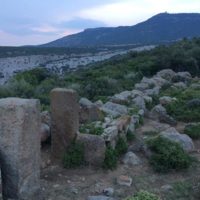Ismaros ancient city
POI Item Type Metadata
Latitude
40.867417
Longitude
25.536789
WebContent
Ismaros ancient city
According to the Homeric tradition, the region was inhabited by the Thracian tribes of Kikones, which had their headquarters in the city Ismaros or Ismara, a city which was located on the slopes of the homonymous mountain ( with its maximum altitude to be 660 meters). The names Ismaros and Maronia have a common etymological root. The acropolis of the city was located a little more south, on the hill of St. George (with an approximate altitude of 461 meters). Maronas is considered to be the founder of the city and he was the priest of the ancient god Apollo, who with his chariot, pulled by white horses, brings the sunlight first at the high peaks of the mountain.
In the picture you can see the remains of the west walls of the ancient city, the megalithic gate and the ancient wine press of the grapes (winepress).
Built out of rough, granitic, igneous rocks from the local region (monzodioritis), it is another undeniable fact and evidence of the habitation of the area since ancient times, but also it is a proof for the existence of organized economy in the region.
Even today, the legend comes to life in this place. The whole area is full of scattered rocks and granitic megaliths, which due to erosion because of time, as well as their exposure to the elements, take odd shapes and forms. They seem, in the visitor’s eyes, that only gigantic, mythical hands could have thrown them.
Site plan of the Acropolis of St. George, as it is presented by the archaeologist D. Lazaridis, in his study for Maronia and Orthagoria. The Acropolis of St. George, is built on a steep location at an altitude of 461 meters in such a way so it could prevent any possible attacks from the east.. The typical polygonal masonry made out of local limestone, which at several places gets cyclopean dimensions, refers to an early date, ranging, according to the findings, from the Late Copper Age - Early Iron Age to the 9th- 8th century BC. But it is almost obvious, that due to its excellent location, the Acropolis of St. George was also used even after the city wall was built, at the acropolis of St. Athanasios (4th century BC). East and south of the Acropolis of St. George, large parts of the long walls are saved, which obviously belonged to the same fortification works with the Acropolis as well as the western part, while the rest parts of the walls had gone through several amendments and additions in different time periods.
According to the Homeric tradition, the region was inhabited by the Thracian tribes of Kikones, which had their headquarters in the city Ismaros or Ismara, a city which was located on the slopes of the homonymous mountain ( with its maximum altitude to be 660 meters). The names Ismaros and Maronia have a common etymological root. The acropolis of the city was located a little more south, on the hill of St. George (with an approximate altitude of 461 meters). Maronas is considered to be the founder of the city and he was the priest of the ancient god Apollo, who with his chariot, pulled by white horses, brings the sunlight first at the high peaks of the mountain.
In the picture you can see the remains of the west walls of the ancient city, the megalithic gate and the ancient wine press of the grapes (winepress).
Built out of rough, granitic, igneous rocks from the local region (monzodioritis), it is another undeniable fact and evidence of the habitation of the area since ancient times, but also it is a proof for the existence of organized economy in the region.
Even today, the legend comes to life in this place. The whole area is full of scattered rocks and granitic megaliths, which due to erosion because of time, as well as their exposure to the elements, take odd shapes and forms. They seem, in the visitor’s eyes, that only gigantic, mythical hands could have thrown them.
Site plan of the Acropolis of St. George, as it is presented by the archaeologist D. Lazaridis, in his study for Maronia and Orthagoria. The Acropolis of St. George, is built on a steep location at an altitude of 461 meters in such a way so it could prevent any possible attacks from the east.. The typical polygonal masonry made out of local limestone, which at several places gets cyclopean dimensions, refers to an early date, ranging, according to the findings, from the Late Copper Age - Early Iron Age to the 9th- 8th century BC. But it is almost obvious, that due to its excellent location, the Acropolis of St. George was also used even after the city wall was built, at the acropolis of St. Athanasios (4th century BC). East and south of the Acropolis of St. George, large parts of the long walls are saved, which obviously belonged to the same fortification works with the Acropolis as well as the western part, while the rest parts of the walls had gone through several amendments and additions in different time periods.
Entrance
Characterization
THN
Files
Collection
Citation
“Ismaros ancient city,” iGuide Repo, accessed December 15, 2025, http://ubuntu01.ceti.gr/omeka/items/show/1621.
Item Relations
| This Item | dcterms:isPartOf | Item: Maronia |
| Item: Ismaros ancient city | dcterms:isPartOf | This Item |
| Item: Ismaros ancient city | dcterms:isPartOf | This Item |
| Item: Ismaros ancient city | dcterms:isPartOf | This Item |
| Item: Ismaros ancient city | dcterms:isPartOf | This Item |
| Item: Ismaros ancient city | dcterms:isPartOf | This Item |





